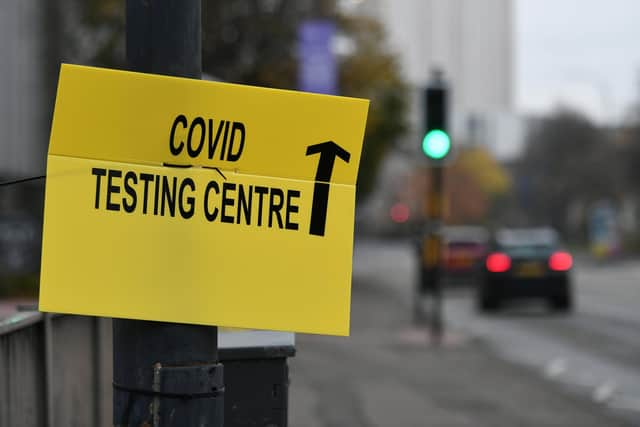Covid Scotland: Where to get a Covid test in Scotland, when do I need to isolate and what is a lateral flow test?
Despite a rapid increase in coronavirus vaccinations across Scotland, with the Scottish Government now reporting that over three and a half million people in the country have now received their first dose, new cases remain high ahead of the country’s anticipated move into level zero next week.
Monday 6 September saw 7,065 new positive coronavirus cases reported by the Scottish Government in a recent spike which Professor Neil Ferguson, member of the UK’s Scientific Advisory Group for Emergencies (SAGE) said would hopefully show a “hint of a plateau” despite a “difficult few weeks” ahead.


Advertisement
Hide AdAdvertisement
Hide AdWith many restrictions across the country now slightly eased, First Minister Nicola Sturgeon has used many of her coronavirus briefings to encourage Scots to get tested for covid-19 regularly – especially before and after travelling or socialising indoors.
Here’s everything you need to know about where to get a Covid test, what a lateral flow test is and when you should self-isolate.
Where can I get a Covid test in Scotland?
If you notice coronavirus symptoms such as a new, continuous cough, high temperature or fever and a loss of, or change in, taste or smell, you should book a polymerase chain reaction (PCR) test within the first three days of your symptoms appearing.
Public Health Scotland say that you should also get tested if you have been asked to by a health protection team, to confirm a positive result or have been in close contact with someone who has tested positive for coronavirus.
You should also book a PCR test if you have been informed by Test and Protect or the Protect Scotland app that you have been identified as a close contact.
You can order a free PCR home testing kit and find out more by visiting https://www.nhsinform.scot/testandprotect.
If you wish to attend a drive through testing centre instead, those currently operating under the UK Government’s testing programme are:
Aberdeen Airport Cumbernauld – Broadwood Stadium Dundee – Dudhope Castle Edinburgh Airport Glasgow Airport Glenrothes - Bankhead Park Inverness - University of the Highlands and Islands campus Prestwick Airport
Advertisement
Hide AdAdvertisement
Hide AdThere are also a wide range of walk-in testing sites, small scale testing sites and mobile testing sites across Scotland, which you can find out more about by visiting the Scottish Government website here.
If you do not have any symptoms, you should instead take a rapid lateral flow test which can be used twice a week to check that you have not contracted coronavirus and are symptomless.
These can likewise be ordered as home-testing kits or booked at local centres.
What is a lateral flow test?
While a PCR test is typically used by those who have coronavirus symptoms such as a new, continuous cough, fever or high temperature and loss of taste or smell, lateral flow tests are supplied in home kits for those who do not show symptoms.
These are rapid tests which can help those mixing with other households, socialising indoors or working with members of the public to check that they are not passing on coronavirus without having symptoms.
According to the NHS, around one in three people infect others with covid-19 after being symptomless, so doing a lateral flow test twice a week every three to four days can help you to keep yourself and others safe by not unknowingly passing it coronavirus on to others.
After rubbing its long cotton swab over your tonsils and inside your nose, you should receive rapid results in 30 minutes.
If you order a rapid lateral flow test at home, you will receive a pack of seven tests and need to report your results online, on the phone or on the Protect Scotland app.
Advertisement
Hide AdAdvertisement
Hide AdIf you receive a positive result you should then self-isolate and do a PCR test to confirm your lateral flow result.
When do I need to self-isolate?
NHS Scotland have said that anyone experiencing coronavirus symptoms should self-isolate immediately to stop the spread of the virus and get tested as soon as possible.
Unlike social distancing or shielding, self-isolating means you should not leave your home if you have, or could have, caught covid-19.
Those who live in the same household as someone who has symptoms should also isolate immediately.
If the person with symptoms receives a negative test, and has not been told they are a close contact of someone who has tested positive, they and the rest of their household no longer need to self-isolate.
But if you receive a positive test result, you will be asked to self-isolate by staying at home and remain as physically separate from others as possible for 10 days.
This is to ensure you do not return to social mixing and risk unknowingly passing the virus on to others before its incubation period is over.
For more information about financial and emotional support available to you during self-isolation, visit the Scottish Government’s support page here.
A message from the Editor:
Thank you for reading this article. We're more reliant on your support than ever as the shift in consumer habits brought about by coronavirus impacts our advertisers.
If you haven't already, please consider supporting our trusted, fact-checked journalism by taking out a digital subscription.
Comments
Want to join the conversation? Please or to comment on this article.
